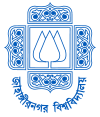
Mohammad Majibur Rahman Professor, Department of Environmental Sciences
PROFILE
SHORT BIOGRAPHY
Mohammad Majibur Rahman
Professor
Department of Environmental Sciences
Email: majibur@juniv.edu
Cell: +8801312112856
Education
BSc (Chemistry Honours, Jahangirnagar University, Bangladesh), 1996
MSc (Physical and Inorganic Chemistry, Jahangirnagar University, Bangladesh), 1997
Supervisor: Dr. Syed Safiullah (deceased)
MSc (Environmental Science, Memorial University of Newfoundland, Canada), 2014
Supervisor: Dr. Erika Merschrod (Department of Chemistry)
PhD (Chemistry & Earth Sciences with ‘Specialization in Chemical and Environmental Toxicology’, University of Ottawa, Canada), 2018
Supervisors: Dr. Robert Jack Cornett (deceased)
Dr. Ian Douglas Clark (Department of Earth Sciences)
Dr. William Edward (Liam) Kieser (Department of Physics)
Graduate Research Projects
• Development of analytical strategies to measure some radioactive isotopes of tin in the environment, PhD Program, University of Ottawa, Canada, 2018
• High-pressure carbon dioxide adsorption on zeolites: Raman and infrared observations, PhD Program (voluntary withdrawal), The University of Western Ontario, Canada, 2014
• Metal thin films as SERS substrates for the detection of PAHs, MSc Program, Memorial University of Newfoundland, Canada, 2013
• Integration of Climate Change into Forest Yield Prediction in the Humber River Basin, MSc Program (incomplete), Sir Wilfred Grenfell College, Canada, 2012
• Determination of arsenic and related chemical species in the groundwater of Bangladesh: an inter-basin comparison, MSc Program, Jahangirnagar University, Bangladesh, 1997
Areas of Research Interest
Environmental chemistry
Environmental toxicology
Environmental radioisotopes
Chemical thermodynamics
Surfactant-drug interactions
Alma mater
Tejgaon College, Dhaka, Bangladesh
Jahangirnagar University, Dhaka, Bangladesh
Sir Wilfred Grenfell College, Corner Brook, Canada
Memorial University of Newfoundland, St. John’s, Canada
The University of Western Ontario, London, Canada
Carleton University, Ottawa, Canada
The University of Ottawa, Ontario, Canada
Instrumental Training
- Atomic Force Microscope (AFM)
- Raman Spectroscopy (Dispersive and FT Raman)
- Infrared Spectroscopy
- Scanning Electron Microscope (SEM)
- UV-Vis Spectroscopy
- Powder X-ray Diffraction
- High Pressure (GPa) measurement by Ruby Fluorescent Method [cryogenic (liquid N2) solid CO2 loading on zeolite)]
- Accelerator Mass Spectrometry (AMS)
- ICP MS (QQQ)
Mohammad Majibur Rahman (MMR) holds a full-time faculty position in the Department of Environmental Sciences at Jahangirnagar University, Bangladesh. He passed the Secondary School Certificate (SSC) and the Higher Secondary Certificate (HSC), both in the first division grades, from Comilla and Dhaka Boards, respectively. After a successful completion of his Master’s degree in Chemistry (thesis title: Determination of Arsenic and Related Chemical Species in Groundwater of Bangladesh: An Inter-basin Comparison, with Prof. Syed Safiullah), he was hired, in 2003, as a Lecturer in the Department of Environmental Sciences.
MMR moved to Canada in 2012 and started his graduate program in Environmental Science at Memorial University of Newfoundland. He was assigned to work on the Humber River Project (HRP) to predict the climate change scenarios using statistical downscaling modelling (SDSM) at Sir Wilfred Grenfell College in Newfoundland. He obtained his MSc degree under the supervision of Prof. Erika Merschrod in the Department of Chemistry. At Memorial University, he worked to monitor the effect of Surface-Enhanced Raman Scattering (SERS) to detect polyaromatic hydrocarbons (PAHs) in surface water; copper and gold thin films were deposited on silicon wafer at a pressure of ~ 10–7 Torr (thesis title: Metal thin films as SERS substrates for the detection of PAHs in waterbody). He also used Atomic Force Microscope (AFM), Scanning Electron Microscope (SEM), and Energy Dispersive X-rays (EDX) to characterize the annealed (400 ºC) samples.
MMR joined with Prof. Yining Huang’s group, Department of Chemistry, at The University of Western Ontario, London, as a doctoral student. He has prepared zeolite, characterized by Powder X-ray Diffraction, for the sequestration of CO2 at high pressure (GPa) on Diamond Anvil Cell (DAC). The cryogenic (liquid nitrogen) sample loading technique was adopted for the sequestration of solid CO2 on the DAC cell (thesis on: High-pressure carbon dioxide adsorption on zeolites: Raman and Infrared observations). The pressure measurements were completed by Ruby Fluorescent Method, and sample characterization was performed using dispersive Raman scattering and FT IR.
MMR transferred his doctoral candidacy from The University of Western Ontario to join with Prof. Jack Cornett’s group at the University of Ottawa (Department of Chemistry) as an NSERC funded CREATE-REACT student with ‘Specialization in Chemical and Environmental Toxicology’. He completed three graduate courses at Carleton University (Chemistry and Biology) as a graduate student of Ottawa-Carleton Institute of Chemistry (OCIC). Unfortunately, Prof. Robert ‘John’ Jack Cornett (1954–2017), a former Canada Research Chair in Radiochemistry and Environmental Health at the University of Ottawa, died suddenly in Ottawa in a tragic bike accident in the crossroads of MMR’s PhD research. Nonetheless, MMR completed his doctoral studies under the supervisions of Prof. Ian Douglas Clark (Department of Earth and Environmental Sciences) and Prof. William Edward (Liam) Kieser (Department of Physics and Director of the A. E. Lalonde Accelerator Mass Spectrometry, AMS). At the Advanced Research Complex (ARC), University of Ottawa, MMR used Triple Quadrupole Inductively Coupled Plasma Mass Spectrometry (QQQ ICP MS, Agilent) technique for the detection of tin and tellurium in aqueous samples (thesis title: Development of analytical strategies to measure some radioisotopes of tin in the environment). His research work was also extended to suppress the 126Te background for the measurement of radioactive 126Sn in environmental samples using 3 MV Accelerator Mass Spectrometry (built on a solid-state tandem Van de Graaff accelerator) at the A. E. Lalonde AMS facility at ARC. The 126Te background was suppressed in the order of ~ 10–12 (126Sn/118Sn) and was observed that SnF3– produces a strong AMS beam-current with little or no TeF3– cesium-sputter yield, thanks to the Ottawa A. E. Lalonde AMS facility! He is also planning to prepare the long-lived 126Sn (half-life, T½ = 2.35 ×105 years) materials by double-neutron capture on stable 124Sn (5.79% natural abundance), via the formation of short-lived 125Sn (T½ = 9.64 days).
Why does 126Sn matter?
Approximately 3,500 stable and radio-nuclides have been identified so far, of which tin has 41 isotopes (mass ranges from 99 to 139). Tin is a magic element which possesses ten stable isotopes, the greatest number of stable isotopes (112Sn, 114Sn, 115Sn, 116Sn, 117Sn, 118Sn, 119Sn, 120Sn, 122Sn, and 124Sn) among all elements in the periodic table. Tin also has two ‘double’ magic isotopes: 100Sn50 (N = 50 neutrons and Z = 50 protons) and 132Sn50 (N = 82 neutrons and Z = 50 protons). 113Sn has a half-life of 115 days, while the half-life of 123Sn is 129 days. The half-life of 126Sn is much longer (~105 years), other isotopes of tin possess half-lives in the order of hours to seconds.
126Sn decays to 126Te with a half-life of 2.35 × 105 years, via the formation of 126Sb intermediate. The transition of 126Sn to 126Sb is followed by the emission of low-energy gamma ray. In the solar system, 126Te is primarily produced by the decay of 126Sn. In order to study the nucleosynthetic processes of 126Te, the elemental fractionation of the parent (Sn) from the daughter (Te) is important. Moreover,
- tin is considered as a potential candidate for the study of isotopic anomalies,
- tin is easily biomethylated by microorganisms; methylated tin compounds are toxic to aquatic species and mammalian body, therefore, biomonitoring of isotopic organotins is of great importance,
- the long-lived isotope of tin, 126Sn (T½ ~105 years), draws much attention in nuclear waste disposal considerations. Also, the measurement of 126Sn in environmental samples is crucial for long-term nuclear waste storage strategies, and nuclear waste treatment practices,
- the measurement of 126Te in the solar system requires a better understanding about the abundance of its parent isotope, 126Sn.
The detection of 126Sn by mass spectrometric methods is, however, hampered by the presence of the stable 126Te (18.84% natural abundance). Therefore, much of MMR’s doctoral project was dedicated for the suppression of 126Te for an effective mass-spectrometric measurement of 126Sn.
RESEARCH INTEREST
Environmental chemistry, Environmental toxicology, Environmental radioisotopes
JOURNAL PAPER
S. Safiullah, A. Kabir, M. M. Rahman, B. K. Howlader. (2003). Kinetics of the removal of arsenic by adsorption-filtration on the hydrated ferric oxide coated mesoporous silica and composite porous materials, Bangladesh J. Environ. Science, 1, 2132., S. Safiullah, M. M. Rahman, S. M. Tareq, M. M. Haque, K. Hassan, M. M. Rahman, B. K. Howlader. (2003). Removal of arsenic by composites of TiO2 and FeOOH, Bangladesh J. Environ. Science, 1, 14, 2003.,
S. Safiullah, A. Kabir, M. M. Rahman, B. K. Howlader. (2003). Kinetics of the removal of arsenic by adsorption-filtration on the hydrated ferric oxide coated mesoporous silica and composite porous materials, Bangladesh J. Environ. Science, 1, 2132.,
S. M. Tareq, S. Safiullah, H. M. Anawar, M. M. Rahman. (2003). T. Ishizuka, Arsenic pollution in groundwater: a self-organizing complex geochemical process in the deltaic sedimentary environment, Bangladesh, Science Total Environment, 313, 213226.,
M. A. A. Mahfuz, J. U. Ahmad, M. S. Sultana, M. M. Rahman, M. A. Gani, M. S. Rahman. (2004). State of physico-chemical properties of wastewater in Bangladesh: Case studies in Dhalai Beel of Dhaka Export Processing Zone, J. Environ. Science (Dhaka), 2, 915.,
S. Safiullah, A. Kabir, K. Hasan, M. M. Rahman. (2004). Comparative study of adsorption-desorption of arsenic on various arsenic removing materials, Journal Bangladesh Academy Sciences, 28(1), 2734.,
M. K Uddin, M. M. Rahman, A. H. M. Saadat, G. Ahmed. (2006). Vertical and spatial distribution of arsenic over a concentric deltaic region of Bangladesh, Journal Environ. Science (Dhaka), 4, 710.,
Anawar, H. M., A. Garcia-Sanchez, M. T. K. Alam, M. M. Rahman. (2008). Phytofiltration of water polluted with arsenic and heavy metals, Intl. J. Environment and Pollution, 33(2/3), 292312.,
S. M. Tareq, S. M. N. Islam, M. M. Rahman, D. A. Chowdhury. (2012). Arsenic pollution in groundwater of southern Asia: an overview on mobilization process and health effects, Bangladesh Journal Environ. Research, 8, 4767.,
H. M. Anawar, J. Akai, M. Mihaljevic, A. M. Sikder, G. Ahmed, S. M. Tareq, M. M. Rahman. (2011). Arsenic contamination in groundwater of Bangladesh: Perspectives on geochemical, microbial and anthropogenic issues, Water, 3(4), 10501076.,
S. M. N. Islam, S. H. Rahman, D. A. Chowdhury, M. M. Rahman, S. M. Tareq. (2012). Seasonal Variations of arsenic in the Ganges and Brahmaputra River, Bangladesh, Journal of Scientific Research, 4(1), 6575.,
M. M. Rahman & R. J. Cornett. (2017). Tin and tellurium separation: an analytical survey on adsorbents, 3MT Presentation, NSERC CREATE-REACT Summer School and Research Day, Laval University, Quebec, June 1114.,
M. M. Rahman, C. MacDonald & R. J. Cornett. (2017). Separation of tin from tellurium: an analytical survey on different substrates, Abstract in the 14th International Conference on Accelerator Mass Spectrometry: Conference Program Posters, Abstract ID 299, Tract classification Poster: SPT, University of Ottawa, August 1415.,
M. M. Rahman, C. MacDonald & R. J. Cornett. (2017). Separation of tin from tellurium: an analytical survey on different absorbing materials for AMS sample preparation, Poster presentation in the 14th International Conference on Accelerator Mass Spectrometry, University of Ottawa, August 1415.,
M. M. Rahman, C. MacDonald & R. J. Cornett. (2018). Separation of tin from tellurium: performance of different extraction chromatographic materials, Separation Science and Technology, 53 (13): 20552063.,
CONFERENCE PAPER
M. K. Uddin, M. M. Rahman, A. H. M. Saadat, G. Ahmed. (2005). Mitigation of arsenic pollution in drinking water through geo-chemical mapping and hydrated ferric oxide (HFO) based on adsorption-filtration and inter-basin comparison of arsenic occurrence in Bangladesh, In: Proceedings on Project Work, Science and Technology for Sustainability, GIST, Republic of Korea, Vol. 3, pp. 113.,SEMINAR
♦ M. M. Rahman & R. J. Cornett. (2016). Separation of Sn from Te, 3MT Presentation, NSERC CREATE-REACT Summer School and Research Day, University of Ottawa, August 28September 1.,Academic Info
Period: 2018
PhD (Chemistry & Earth Sciences with ‘Specialization in Chemical and Environmental Toxicology’, University of Ottawa, Canada), 2018
Period: 2014
MSc (Environmental Science, Memorial University of Newfoundland, Canada), 2014
Period: 1997
MSc (Physical and Inorganic Chemistry, Jahangirnagar University, Bangladesh),
Period: 1996
BSc (Chemistry Honours, Jahangirnagar University, Bangladesh),
Period: 2015-2018
Contact
Mohammad Majibur Rahman
Professor
Department of Environmental Sciences
Jahangirnagar University, Savar, Dhaka-1342, Bangladesh.
Cell Phone: +8801312112856
Work Phone: 02224491045-51, ext. 2157
Email: majibur@juniv.edu

